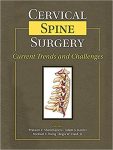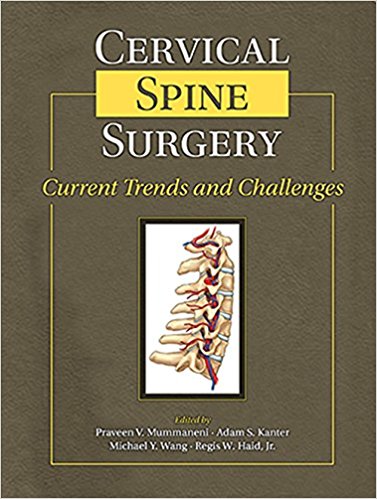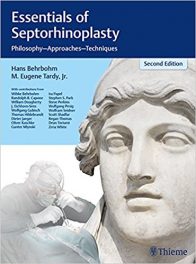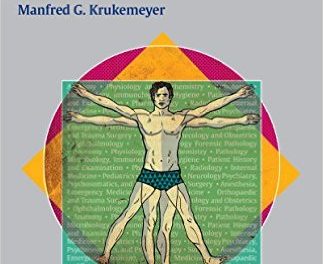 Editors: Praveen M. Mummaneni, MD: Adam S. Kanter, MD; Michael Y. Wang, MD; and Regis W. Haid, Jr., MD
Editors: Praveen M. Mummaneni, MD: Adam S. Kanter, MD; Michael Y. Wang, MD; and Regis W. Haid, Jr., MD
Publisher: Thieme – 615 pages
Book Review by: Nano Khilnani
In additional to the anatomical, physiological and other information the editors and contributors acquired in the course of their respective studies in medical school, training and practice in internship, residency and fellowship, they also gathered detailed knowledge in the course of their work experience, and developed valuable insight when performing surgery on their patients.
All of this is reflected in this excellent, unique textbook wherein are explained in detail the surgical procedures, and also shown with rich graphics.
Ninety specialists in cervical spine surgery from all around the United States and four other countries – Austria, Canada, Japan, and Taiwan – authored the 41 chapters of this large book. The chapters are organized around five Parts that we name below to provide you a broad overview of the contents:
- Part I. Basic Considerations
- Part II. Arthroplasty Techniques
- Part III. Biomaterials for Fusion
- Part IV. Minimally Invasive Techniques
- Part V. Regional and Junctional Challenges
In addition, instead of listing the titles of the chapters as we typically do in book reviews, we alphabetically name below the topics covered and discussed in each of the five Parts, to enable you to know which aspects of cervical spine surgery you will be able to find some information on, in this book of over 600 pages:
- Basic Considerations: biomechanics of the cervical spine, cervical spine: relevant anatomy, cervical techniques with image-guided spinal navigation, history and evolution of cervical spine surgery, and minimally invasive versus open surgery.
- Arthroplasty Techniques: arthroplasty materials tribology, biomechanics of cervical disc arthroplasty, Bryan disc techniques and outcomes, cervical nucleus replacement, discover cervical disc technique and outcomes, heteroscopic ossification after arthroplasty, multilevel arthroplasty: patient selection, porous coated motion disc technique and outcomes, Prestige LP cervical disc: techniques and outcomes, Prestige ST technique and outcomes, ProDisc-C techniques and outcomes, and single-level arthroplasty: patient selection.
- Biomaterials for Fusion: biomechanics of polymers used in cervical fusion, bone morphogenetic protein in anterior cervical fusion, cervical corpectomy techniques using bone, mesh, polyetheretherketone (PEEK), and carbon fiber, multilevel anterior cervical discectomy and fusion versus corpectomy, resorbable anterior plates, and resorbable cervical interbody spacers.
- Minimally Invasive Techniques: anterior and lateral approaches to the vertebral artery and nerve root, cervical laminectomy and posterior fusion, expansive laminoplasty, minimally invasive posterior cervical foraminotomy and discectomy, posterior cervical fusion, posterior laminectomy for cervical stenosis, resection of intradural extramedullary cervical tumors, and treating cervical spine trauma.
- Regional and Junctional Challenges: cervicothoracic fusion, cervical osteotomy for kyphosis, complex transoral techniques for the upper cervical spine, C1 lateral mass fixation, C2 pars, pedicle, and laminar screw fixation, endoscopic endonasal approach to the odontoid, occipitocervical fusion, transarticular screw fixation, transoral odontoidectomy, and trans-sternal approach to the cervicothoracic junction and upper thoracic spine.
DVD Videos:
- Cervical Kyphosis Correction
- C2 Translaminar Screw Technique
- Endonasal Approach to the Odontoid
- Minimally Invasive Expansive Laminoplasty
The goal of this book as stated by the editors in their Preface is “to highlight the subtleties of these modern surgical procedures while providing the reader with a thorough understanding of their utility, as well as their potential drawbacks.”
To give you an idea of how the material is outlined and presented in this book’s chapters, let us take a look at chapter 24, Minimally Invasive Posterior Cervical Foraminatomy and Discetomy, on pages 333-346. It covers a problem – cervical radiculopathy – that affects a large number of people: as many as 2.5 million individuals in the United States, according to the authors of this chapter Tim E. Adamson and Demagoj Coric.
Most of such cases are resolved with physical therapy, chiropractic care, and epidural steroid injections, but as many as about 25 percent (about 625,000) require surgery for relief of symptoms. This surgical procedure – posterior cervical foraminotomy – originated in the 1940s, and 1950s when the pioneers Stookey, Frykholm, Murphey, and Simmons had standardized the technique and were publishing excellent results with over 90 percent positive outcomes, and a very low – 1.5 percent – complication rate.
Through the rest of this chapter, the material is discussed and illustrated under these topic headings:
- Indications and Contraindications
- Preoperative Assessment and Evaluation
- Preoperative Planning
- Surgical Technique
- Postoperative Care
- Complications and Outcomes
- Results
- Conclusion
- References
This textbook is an excellent resource detailing the current state of cervical spine surgery, with positive as well as negative outcomes and challenges to overcome. It provides step-by-step surgical procedures along with graphics such as charts, drawings, radiographs, detailed sketches, and tables. Another benefit for the purchasers of this book is the DVD with four videos attached on the inside back cover. All in all, this is a very useful and important resource.
Editors:
Praveen M. Mummaneni, MD is Professor and Vice Chairman of Neurosurgery in the Department of Neurological Surgery at the University of California San Francisco in San Francisco, California.
Adam S. Kanter, MD is Assistant Professor of Neurological Surgery, Director of the Minimally Invasive Spine Surgery Program, and Director of the Neurological Spine Fellowship in the Department of Neurological Surgery at the University of Pittsburgh Medical Center Presbyterian in Pittsburgh, Pennsylvania.
Michael Y. Wang, MD, FACS is Professor of Neurosurgery and Rehabilitation Medicine in the Department of Neurological Surgery at Miller School of Medicine at the University of Miami in Miami, Florida.
Regis W. Haid, Jr., MD is with the Atlanta Brain and Spine Center, and is Medical Director of the Piedmont Spine Center and Neuroscience Service Line at Piedmont Hospital in Atlanta, Georgia.







